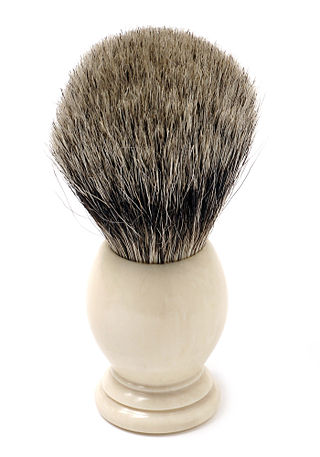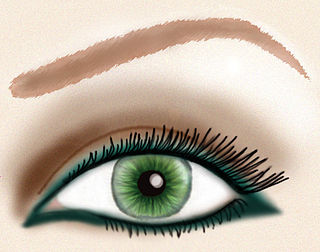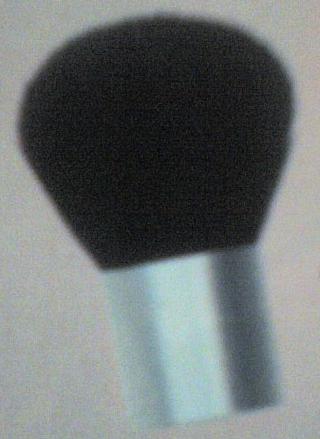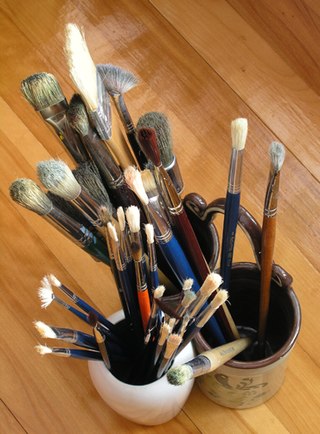
Oil painting is a painting method involving the procedure of painting with pigments with a medium of drying oil as the binder. It has been the most common technique for artistic painting on canvas, wood panel or copper for several centuries, spreading from Europe to the rest of the world. The advantages of oil for painting images include "greater flexibility, richer and denser colour, the use of layers, and a wider range from light to dark". But the process is slower, especially when one layer of paint needs to be allowed to dry before another is applied.

Cosmetics are composed of mixtures of chemical compounds derived from either natural sources or synthetically created ones. Cosmetics have various purposes. Those designed for personal care and skin care can be used to cleanse or protect the body and skin. Cosmetics designed to enhance or alter one's appearance (makeup) can be used to conceal blemishes, enhance one's natural features, add color to a person's face, or change the appearance of the face entirely to resemble a different person, creature or object. Cosmetics can also be designed to add fragrance to the body.

A pin-up model is a model whose mass-produced pictures and photographs have wide appeal within the popular culture of a society. Pin-up models are usually glamour models, actresses, and fashion models whose pictures are intended for informal, aesthetic display, such as being pinned onto a wall. Beginning in the 1940s, pictures of pin-up girls were also known as cheesecake in the U.S.

Mascara is a cosmetic commonly used to enhance the upper and lower eyelashes. It is used to darken, thicken, lengthen, and/or define the eyelashes. Normally in one of three forms—liquid, powder, or cream—the modern mascara product has various formulas; however, most contain the same basic components of pigments, oils, waxes, and preservatives. The most common form of mascara is a liquid in a tube with an application brush.

A concealer or color corrector is a type of cosmetic that is used to mask imperfections on the skin. These imperfections can include dark circles under the eyes, blemishes, and hyperpigmentation. Concealer is similar to, and can be used in conjunction with foundation, a lighter cosmetic that is used to even out the skin tone. Both concealer and foundation are typically used to make skin appear smoother and more uniform in color. These two types of cosmetics differ in that concealers tend to be more heavily pigmented, though concealer and foundation are both available in a wide range of colors and opacities.

A shaving brush or shave brush is a small brush with a handle parallel to the bristles used to make lather from shaving soap or shaving cream and apply it to the face when shaving. Shave brushes are often decorative; antique handles are often made from materials such as ivory or even gold, though the bristle load may be composed of any number of natural or synthetic materials. The shave brush is used most often today by "wet shavers" in tandem with a single- or double-edged safety razor or a straight razor. However, this is not always the case, as shavers of all varieties may employ the tool.

Rouge, also called blush or blusher, is a cosmetic for coloring the cheeks in a variety of shades, or the lips red. It is applied as a powder, cream or liquid.

Eye liner or eyeliner is a cosmetic used to define the eyes. It is applied around the contours of the eye(s). It is often used to create various aesthetic effects.

Eye shadow is a cosmetic applied primarily to the eyelids to attract attention to the wearer's eyes, making them stand out or look more attractive. Eye shadow can also be applied under the eyes, on the cheeks, or to brow bones.

The history of cosmetics spans at least 7,000 years and is present in almost every society on earth. Cosmetic body art is argued to have been the earliest form of a ritual in human culture. The evidence for this comes in the form of utilised red mineral pigments including crayons associated with the emergence of Homo sapiens in Africa. Cosmetics are mentioned in the Old Testament—2 Kings 9:30 where Jezebel painted her eyelids—approximately 840 BC—and the book of Esther describes various beauty treatments as well.

Animal fibers are natural fibers that consist largely of certain proteins. Examples include silk, hair/fur and feathers. The animal fibers used most commonly both in the manufacturing world as well as by the hand spinners are wool from domestic sheep and silk. Also very popular are alpaca fiber and mohair from Angora goats. Unusual fibers such as Angora wool from rabbits and Chiengora from dogs also exist, but are rarely used for mass production.
False eyelashes are a cosmetic enhancement attaching synthetic or natural fibers to the eyelids to give the natural eyelashes a fuller, more dramatic look. They are available in various lengths, thicknesses, and curvatures.

Foundation is a liquid, cream, or powder makeup applied to the face and neck to create an even, uniform color to the complexion, cover flaws and, sometimes, to change the natural skin tone. Some foundations also function as a moisturizer, sunscreen, astringent or base layer for more complex cosmetics. Foundation applied to the body is generally referred to as "body painting" or "body makeup".

Cosmetics in the 1920s were characterized by their use to create a specific look: lips painted in the shape of a Cupid's bow, kohl-rimmed eyes, and bright cheeks brushed with bright red blush.

Theatrical makeup is makeup that is used to assist in creating the appearance of the characters that actors portray during a theater production.
A cosmetic primer is a cream applied before another cosmetic to improve coverage and lengthen the amount of time the cosmetic lasts on the face.
Taklon is the common name for a synthetic fiber used in artist-quality paint, makeup, shaving and pin stripe brushes. It is a smooth, soft, and somewhat fragile polyester derivative devoid of any protein component or allergen elements and is therefore used in the cosmetic industries as a "green," "vegan," "allergy free" or synthetic alternative to animal hair brushes.

A kabuki brush, sometimes called mushroom brush, is a makeup brush with dense bristles and a short handle. The brush head is usually rounded, though it can also be flat. Traditionally, the bristles are made of natural materials like animal hair, such as from horses or goats, but most modern brushes have synthetic bristles.
Oshiroi (白粉) is a powder foundation traditionally used by kabuki actors, geisha and their apprentices. The word is written with kanji meaning "white powder", and is pronounced as the word for white with the honorific prefix o-.

A paintbrush is a brush used to apply paint or ink. A paintbrush is usually made by clamping bristles to a handle with a ferrule. They are available in various sizes, shapes, and materials. Thicker ones are used for filling in, and thinner ones are used for details. They may be subdivided into decorators' brushes used for painting and decorating and artists' brushes use for visual art.

















